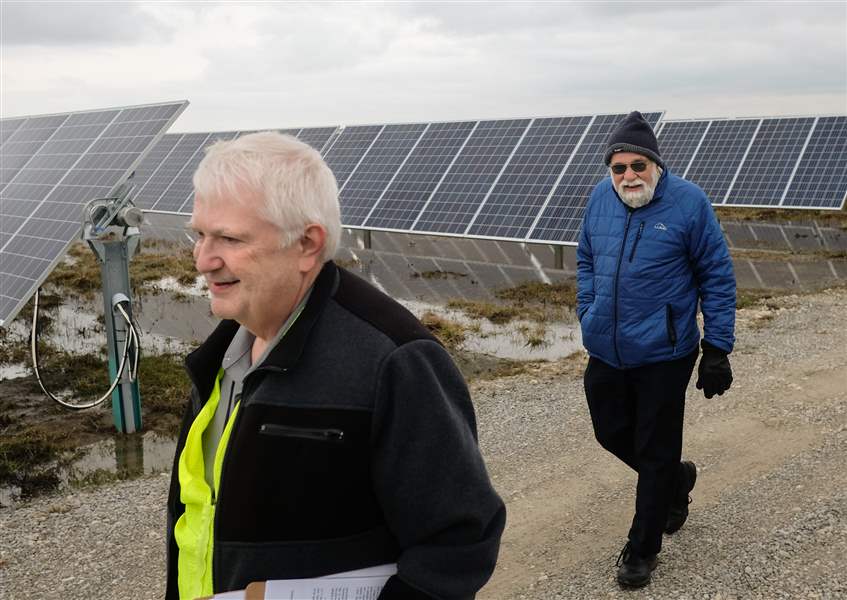
Ohio's solar energy industry spawns new research
2/27/2018
Daryl Stockburger, assistant Bowling Green Utilities director, and Professor Donald Scherer walk through Ohio's largest collection of solar arrays Feb. 21 in Bowling Green, Ohio. It's a 165-acre field with more than 85,000 panels.
THE BLADE/JEREMY WADSWORTH
Buy This Image
BOWLING GREEN — As Ohio's commitment to solar energy continues to grow, a new era of research is starting to emerge for this state — one that seeks better use of land and airspace in and around massive solar panel arrays.
Following the lead of similar projects in Minnesota, the U.S. Fish and Wildlife Service is working with Pheasants Forever, Quail Forever, and other conservation groups on developing habitat for pollinators such as bees and monarch butterflies, as well as just generally beautifying sites or making them more attractive to other forms of wildlife, such as birds.
The goal is to find the right combination of small plants — native wildflowers, shrubs, and grasses — that grow no more than 2 feet tall so as not to obstruct solar panels. The plantings are to serve at least one more function, such as helping out to some degree in keeping algae-growing phosphorus and other farm fertilizers from entering local ditches and streams.
There also are hopes for an educational component that goes beyond electricity produced by solar panels themselves.
On city-owned agricultural land that Bowling Green has leased to NextEra Energy Resources and American Municipal Power Inc. for solar-energy production, biologists plan to use a $49,000 research grant to see which plants are most compatible inside a solar field, as well as along its perimeter.
If successful, the Wood County Parks District will bring school groups, farmers, and others to the site to show them examples of how clean energy can be produced in the thick of wildlife habitat — an environmental two-for-one.
“It should be pretty,” said Daryl Stockburger, assistant Bowling Green utilities director.
Donald Scherer, a retired Bowling Green State University professor who founded BGSU’s applied philosophy program and specialized in environmental ethics, loves the idea of enhancing youth education.
“It’s very important as a model, because we’re going to have more solar across Ohio,” he said.
Signs point to a surge in solar energy across Ohio now that the state’s highly controversial, two-year hiatus on renewable energy mandates has expired.
The law, which requires at least 12.5 percent of Ohio’s energy to come from renewable energy by 2027, has been fought vigorously by utility giant FirstEnergy Corp. and conservatives in the Ohio General Assembly. Gov. John Kasich irritated them at the end of 2016 when he announced he would not extend the two-year freeze he’d signed in 2014 by another two years.
Environmentalists hailed that as a sign that Ohio was open for renewable-energy business again, claiming the 2014 freeze had sent the wrong market signals. The Buckeye State continues to be the only one that has had such a freeze.
The 20-megawatt solar field that NextEra and AMP began operating northeast of Bowling Green in January, 2017, is now Ohio’s largest. It surpassed a 12-megawatt facility in Wyandot County.
As large as the Bowling Green project is — 85,000 solar panels erected across 165 acres — its reign as Ohio’s solar king is likely to be short-lived.
On Feb. 15, the Ohio Power Siting Board approved plans by Hardin Solar Energy LLC for a 150-mw solar field on 1,115 acres in Hardin County to be known as the Hardin Solar Center. It is more than seven times larger than the Bowling Green project. That site is between Lima, Ohio, and Columbus.
That same day, the OPSB also approved plans by Blue Planet Renewable Energy LLC for a massive, 125-mw project on 1,100 acres in Brown County, east of Cincinnati, to be called Hillcrest Solar I. That’s more than six times larger than the Bowling Green project.
The state board also has under review an application for an additional 125-mw project. That one, if approved, would be in Vinton County, which is southeast of Columbus.
Research for those and other mega projects is starting in Bowling Green, where the U.S. Fish and Wildlife Service will first begin work this spring on restoring 13.4 acres along the perimeter of the NextEra-AMP solar field. The eventual plan is to follow that up with a research project involving 10 acres inside the fence and beneath the panels.
Michael D. Retterer, Pheasant Forever Inc. and Quail Forever wildlife biologist, said the ability to provide more habitat for pollinators and birds “will add diversity to the county landscape and provide much-needed annual stopover and/or nesting habitat for those species.”
Mr. Retterer, who runs the Ohio Pollinator Habitat Initiative for those groups, said area crop yields could improve with more local pollinators.
“Many fruits and vegetables require pollination and, therefore, providing habitat to increase the presence of pollinators would be beneficial,” he said.
Bowling Green gets 13.74 of the 20 mw produced by the NextEra solar field, roughly 4 percent of the city’s energy needs, Mr. Stockburger said.
The project marked its first anniversary in January.
“We’re very happy with it,” Mr. Stockburger said.
The solar field was built on city-owned farmland along Carter Road north of Gallier Road.
Contact Tom Henry at thenry@theblade.com, 419-724-6079, or via Twitter @ecowriterohio.